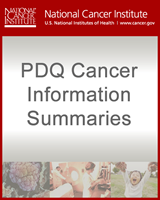From: Genetics of Skin Cancer (PDQ®)

PDQ Cancer Information Summaries [Internet].
Bethesda (MD): National Cancer Institute (US); 2002-.
NCBI Bookshelf. A service of the National Library of Medicine, National Institutes of Health.
| Syndrome (OMIM link) | Inheritance | Chromosome | Gene | Clinical Findings |
|---|---|---|---|---|
| Basal cell nevus syndrome, Gorlin syndrome | AD | 9q22.3-q31 [36] | PTCH1 [120,121] | BCC (before age 20 y) |
| 3.597–6.457 [36] | PTCH2 [39] | |||
| 10q24.32 | SUFU [63] | |||
| Rombo syndrome | AD | Milia, atrophoderma vermiculatum, acrocyanosis, trichoepitheliomas, and BCC (age 30–40 y) | ||
| Bazex-Dupré-Christol syndrome | XD > AD | Xq24-27 [109] | Unknown | Hypotrichosis (variable),[106] hypohidrosis, milia, follicular atrophoderma (dorsal hands), and multiple BCCs (aged teens to early 20s)[106] |
| Brooke-Spiegler syndrome | AD | 16q12-q13 [122,123] | CYLD [124,125] | Cylindroma (forehead, scalp, trunk, and pubic area),[126,127] trichoepithelioma (around nose), spiradenoma, and BCC |
| Multiple hereditary infundibulocystic BCC | AD [128] | Unknown | Unknown | Multiple BCC (infundibulocystic type) |
| Schopf-Schultz-Passarge syndrome | AR > AD | Unknown | Unknown | Ectodermal dysplasia (hypotrichosis, hypodontia, and nail dystrophy [anonychia and trachyonychia]), hidrocystomas of eyelids, palmo-plantar keratosis and hyperhidrosis, and BCC[129] |
AD = autosomal dominant; AR = autosomal recessive; OMIM = Online Mendelian Inheritance in Man; XD = X-linked dominant.
From: Genetics of Skin Cancer (PDQ®)

NCBI Bookshelf. A service of the National Library of Medicine, National Institutes of Health.